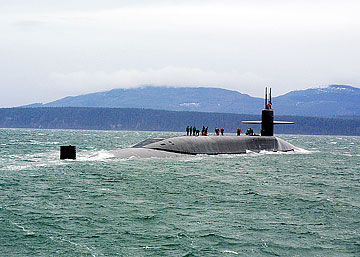
U.S. NAVY PHOTO
The USS Ohio stops for a personnel boat transfer off the coast of Puget Sound, Wash. CLICK FOR LARGE
|
|
Submarine crew change
A transition at Pearl Harbor allows the USS Ohio to take on new sailors for deployment
PEARL HARBOR'S Bravo Pier was a crowded scene last week when for the first time a nuclear ballistic missile submarine, normally based in the Pacific Northwest, transferred its crew of 160 sailors.
Since 1960 the Navy's fleet of nuclear ballistic missile submarines has maintained two crews (Blue and Gold), said Capt. Chris Ratliff, who commands the USS Ohio's Blue crew.
"The purpose of the dual crews is to maximize the time the submarine is at sea," said Ratliff, a 1983 Naval Academy graduate. "We're at sea 70 percent of the time and constantly available to the commander. No other force can make that claim. The purpose is to stay forward deployed for extended periods of time."
But the transfer of crews, about every three months, previously always happened at the sub's homeport. For the USS Ohio, a converted nuclear ballistic missile sub, this meant transferring a crew of nearly 200 along with more than four dozen large containers containing supplies, paper work and tools in Washington state.
USS OHIO
Commissioned: Nov. 11, 1981
Length: 560 feet
Missile tubes: 24 (154 Tomahawk missiles)
Crew: 24 officers, enlisted: 227
Special Operations personnel: 66
Source: U.S. Navy
|
This time, Ratliff brought the Ohio from its homeport at Kitsap Naval Base in Bangor, Wash., to Pearl Harbor last week and was relieved by Capt. Andrew Hale and 160 sailors from his Gold crew. Hale's Gold crew was flown from McChord Air Force Base near Seattle by military transport to Hawaii.
Hale had three days for the crew swap, which also included accommodating another 40 extra personnel who will help train and test the new crew here. Also loaded were fresh food supplies that will have to sustain the crew for nearly three months.
"It was very challenging," said Ratliff, who has been in the submarine service for 24 years, "to turn over a ship when it is not at its homeport. But Pearl Harbor was extremely accommodating and helpful."
Ratliff estimated that the Navy saved about a month by changing crews at Pearl Harbor.
"The schedule is so tight in getting this ship ready for deployment," said Ratliff.
While in Hawaii, the Ohio will test its dry dock shelter, which is used in special warfare operations, and evaluate other systems.
Hale will command the Ohio for the next three months and then take the sub back to Bangor.

U.S. NAVY PHOTO
Above, the strategic missile submarine USS Michigan was assisted by a commercial tugboat while the sub conducts mooring operations at Puget Sound Naval Shipyard. The sub, along with the USS Ohio and two other subs, will undergo a conversion from a strategic missile class to a guided missile class submarine. CLICK FOR LARGE
|
|
Ratliff and his Blue crew will then take the Ohio on its first one-year deployment in fall 2008, with a crew change at sea planned every three months.
Ratliff said a sailor on a nuclear submarine stays with the same crew for about three to five years, usually working his way up the ranks. Then he pulls an assignment ashore for two years and then returns to sea for another two to five years.
Despite missing Thanksgiving, Christmas and New Years because they were on deployment, Ratliff said the morale of his Blue crew is "very high."
"They are dedicated sailors," Ratliff added, "and they are always ready."
The 560-foot ballistic missile submarine, commissioned in 1981, was the first of 18 Ohio-class boats that carried 24 Trident ballistic missiles. The Navy at one time maintained 41 ballistic missile submarines. The Trident missiles were part of the military's "triad" of nuclear deterrent during the Cold War, coupled with land-based missiles and manned bombers.
Ratliff said that rather than decommission these 18 submarines as the Cold War ended, four were converted to carry out special operations missions.
The Ohio's 24 Trident missile tubes were reconfigured to carry 154 Tomahawk missiles, switching from a nuclear deterrent to a source of more conventional weaponry to meet the demands of the war on terrorism.
Besides the Ohio, three other Trident submarines -- USS Michigan, Florida and Georgia -- were slated for conversion. The submarines also were outfitted to accommodate at least 66 Navy SEALs.

